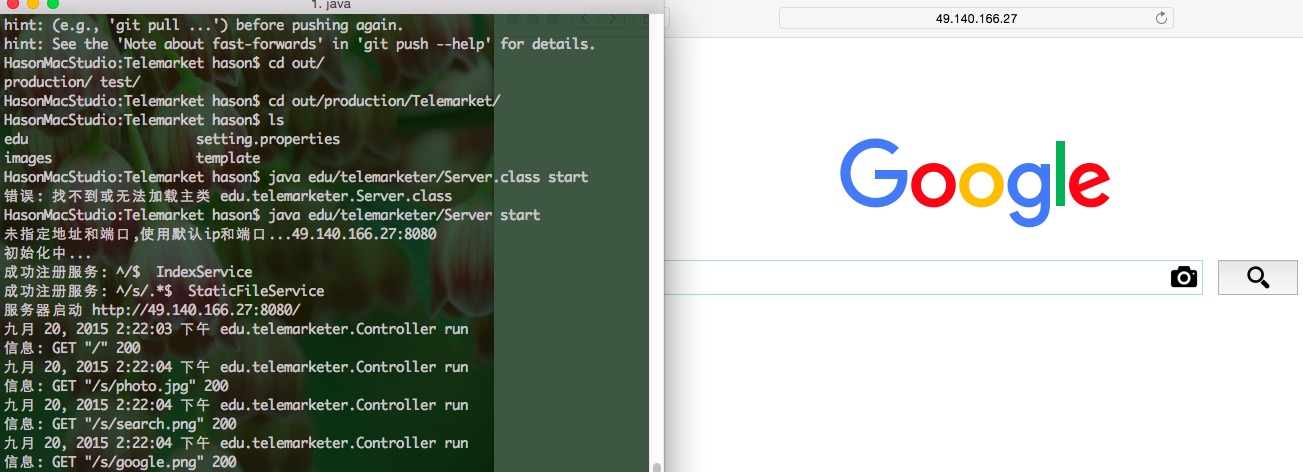徒手用Java来写个Web服务器和框架吧<第一章:NIO篇>
接上一篇,说到接受了请求,接下来就是解析请求构建Request对象,以及创建Response对象返回。
多有纰漏还请指出。省略了很多生产用的服务器需要处理的过程,仅供参考。可能在不断的完善中修改文章内容。
先上图

// 2015年09月30日 更新请求的解析部分
项目地址: https://github.com/csdbianhua/Telemarketer
首先看看如何解析请求
解析请求 构建Request对象
一个HTTP的GET请求大概如下所示。
GET / HTTP/1.1
Host: 123.45.67.89
Connection: keep-alive
Cache-Control: max-age=0
...
一个HTTP的POST请求大概如下
POST /post HTTP/1.1
Host: 123.45.67.89
Connection: keep-alive
Cache-Control: max-age=0
Content-Type: application/x-www-form-urlencoded
Content-Length: 14
...
\r\n
one=23&two=123
请求行以一个方法符号开头,以空格分开,后面跟着请求的URI和协议的版本。 接下来就是一系列的头域,我们先不管每个的作用,先把他们提取出来保存到Request对象里再说。 每行结尾都有一个\r\n,并且除了作为结尾的\r\n外,不允许出现单独的\r或\n字符。 而post方法有个消息体,与HTTP头之间由一个\r\n隔开。
首部和消息体肯定是要分开解析的。那么我们的Request对象包含一个RequestHeader 和 RequestBody
1 private final RequestHeader header; 2 private final RequestBody body;
Header中我们有这几项
1 private String URI; 2 private String method; 3 private Map<String, String> head; 4 private Map<String, String> queryMap;
Body中我们有这几项
1 private Map<String, String> formMap; 2 private Map<String, MIMEData> mimeMap;
formMap是x-www-form-urlencoded数据(exp. user=123&key=4563),mimeMap是form-data格式上传的数据,包括文件一类的。MIMEData就是保存着类型,文件名,数据。
好,现在可以开始进行下一步处理了。
第一步:读取数据
1 ByteBuffer buffer = ByteBuffer.allocate(1024); 2 channel.read(buffer); 3 buffer.flip();
创建一个缓冲区,然后读取数据。然后调整一下position的位置。不然顺着已写入的位置继续往下读是完全没有数据的。
flip()的作用不用多说了吧 看源代码就做了这么几件事 limit = position; position = 0; mark = -1;
第二步:斩首HTTP请求
因为我们并不知道请求有多长,读到多少为止,但是这一次读取几乎肯定是读完了头部的。
所以我们得先把头部解析出来,然后再根据Content-Length的值或者没有Content-Length来确定还要继续读多少。
先把已读到的数据拿到再说
1 int remaining = buffer.remaining(); 2 byte[] bytes = new byte[remaining]; 3 buffer.get(bytes);
然后找到 两个\r\n同时出现的地方,那就是我们要找的头部的尾端。
1 int position = BytesUtil.indexOf(bytes, "\r\n\r\n"); 2 if (position == -1) { 3 throw new IllegalRequestException("请求不合法"); 4 } 5 byte[] head = Arrays.copyOf(bytes, position); 6 RequestHeader requestHeader = new RequestHeader(); 7 requestHeader.parseHeader(head); //IOException
这样头部就分出来了。
第三步:读取完Body
1 int contentLength = requestHeader.getContentLength(); 2 buffer.position(position + 4); 3 ByteBuffer bodyBuffer = ByteBuffer.allocate(contentLength); 4 bodyBuffer.put(buffer); 5 while (bodyBuffer.hasRemaining()) { 6 channel.read(bodyBuffer); //IOException 7 } 8 byte[] body = bodyBuffer.array(); 9 RequestBody requestBody = new RequestBody(); 10 if (body.length != 0) { 11 requestBody.parseBody(body, requestHeader); 12 }
接下来是详细的header和body的解析
Header解析
头基本就是UTF-8编码了,直接br读就行。
BufferedReader reader = new BufferedReader(new StringReader(new String(head,"UTF-8")));
读第一行 用空格分开,第一个就是请求方法,第二个就是uri。 注意要使用 URLDecoder.decode(lineOne[1], "utf-8"); 进行解码uri,因为会可能会包括%20等转义字符。
接下来读取每一行 String[] keyValue = line.split(":"); 再去掉空格添加到headMap里 headMap.put(keyValue[0].trim(), keyValue[1].trim()); 头就读完了。
然后是Get的Query String。
1 Map<String, String> queryMap = Collections.emptyMap();
2 int index = path.indexOf('?');
3 if (index != -1) {
4 queryMap = new HashMap<>();
5 Request.parseParameters(path.substring(index + 1), queryMap);
6 path = path.substring(0, index);
7 }
1 static void parseParameters(String s, Map<String, String> requestParameters) { 2 String[] paras = s.split("&"); 3 for (String para : paras) { 4 String[] split = para.split("="); 5 requestParameters.put(split[0], split[1]); 6 } 7 }
Body解析
先判断Content-Type再进行对应的解析。
1 if (contentType.contains("application/x-www-form-urlencoded")) { 2 try { 3 String bodyMsg = new String(body, "utf-8"); 4 parseParameters(bodyMsg, formMap); 5 } catch (UnsupportedEncodingException e) { 6 logger.log(Level.SEVERE, "基本不可能出现的错误 编码方法不支持"); 7 throw new RuntimeException(e); 8 } 9 } else if (contentType.contains("multipart/form-data")) { 10 int boundaryValueIndex = contentType.indexOf("boundary="); 11 String bouStr = contentType.substring(boundaryValueIndex + 9); // 9是 `boundary=` 长度 12 mimeMap = parseFormData(body, bouStr); 13 }
x-www-form-urlencoded 的内容是这样的
one=23&two=123
multipart/form-data 的内容是这样的
------WebKitFormBoundaryIwVsTjLkjugAgonI Content-Disposition: form-data; name="photo"; filename="15-5.jpeg" Content-Type: image/jpeg \r\n ..... ------WebKitFormBoundaryIwVsTjLkjugAgonI Content-Disposition: form-data; name="desc" some words ------WebKitFormBoundaryIwVsTjLkjugAgonI
这个解析复杂一些,不过都是一些简单的操作。具体看源码。
这样Request就出来了。
创造响应 构建Response对象
先看一个简化的Http响应
HTTP/1.1 200 OK
Date: Sun, 20 Sep 2015 05:04:55 GMT
Server: Apache
Content-Type: text/html; charset=utf-8
Content-Length: 100
\r\n
...
Response头
先不考虑其他设置Cookie等头域,浏览器主要想知道HTTP协议版本、返回码、内容种类和内容长度。 那我们就考虑这几项先。
- 首先协议版本固定为 HTTP/1.1
- 响应码我们写个枚举类Status定
- Date 要是rfc822格式
- Content-Type 和 Content-Length 根据内容定
Response的成员变量只需
private Status status;
private Map<String, String> heads;
private byte[] content;
先来看看Date
Date域
使用一个SimpleDateFormat格式化时间成rfc822,注意要将Locale设置成English。
SimpleDateFormat simpleDateFormat = new SimpleDateFormat("EEE, d MMM yyyy HH:mm:ss zzz", Locale.ENGLISH);
但是这样时区不对,那我们再设置一下时区 static { simpleDateFormat.setTimeZone(TimeZone.getTimeZone("GMT")); }
Content-Type域
如果是文本类型需要用户指定,比如Json。 使用 URLConnection.getFileNameMap().getContentTypeFor(path) 即可获得文件路径对应的MIME类型。同时如果是文本类型,需要写出charset。
if (contentType.startsWith("text")) {
contentType += "; charset=" + charset;
}
Content-Length域
设置成content.length就好了。
Response体
如果内容是文件 Files.readAllBytes(FileSystems.getDefault().getPath(path)); 就可以读取所有的字节。 如果内容是文本,直接编码成UTF-8就好了。当然一般来说是Json文本,那么Content-Type需要设置为application/json; charset=utf-8 。这个可以用户指定。
返回ByteBuffer
由于最后写入SocketChannel需要ByteBuffer,那么我们需要将响应变成ByteBuffer。按格式写好转换成ByteBuffer就行。
1 private ByteBuffer finalData = null; 2 public ByteBuffer getByteBuffer() { 3 if (finalData == null) { 4 heads.put("Content-Length", String.valueOf(content.length)); 5 StringBuilder sb = new StringBuilder(); 6 sb.append(HTTP_VERSION).append(" ").append(status.getCode()).append(" ").append(status.getMessage()).append("\r\n"); 7 for (Map.Entry<String, String> entry : heads.entrySet()) { 8 sb.append(entry.getKey()).append(": ").append(entry.getValue()).append("\r\n"); 9 } 10 sb.append("\r\n"); 11 byte[] head = sb.toString().getBytes(CHARSET); 12 finalData = ByteBuffer.allocate(head.length + content.length + 2); 13 finalData.put(head); 14 finalData.put(content); 15 finalData.put((byte) '\r'); 16 finalData.put((byte) '\n'); 17 finalData.flip(); // 记得这里需要flip 18 } 19 return finalData; 20 }
这里使用了一个finalData保存最后的结果,一旦调用就不可修改了,同时防止重复读取时发送同一个内容。不然的话每读一次 hasRemaining 都为true。



